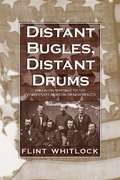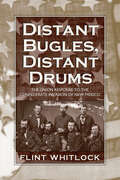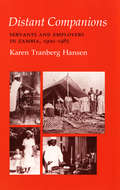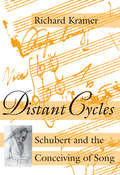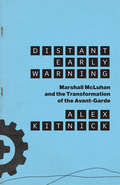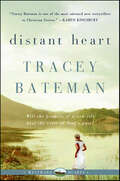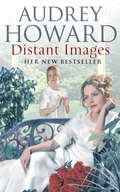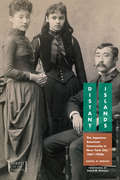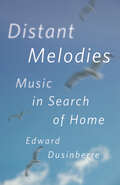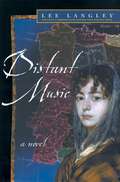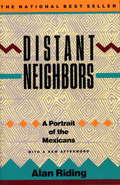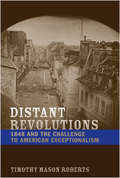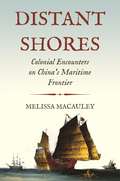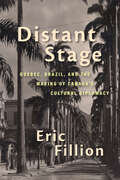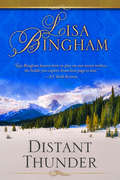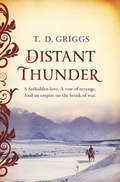- Table View
- List View
Distant Bugles, Distant Drums
by Flint WhitlockDistant Bugles, Distant Drums brings to life the epic march of 1,000 men recruited from Colorado's towns, farms, and mining camps to fight 3,000 Confederate soldiers in New Mexico.
Distant Bugles, Distant Drums: The Union Response to the Confederate Invasion of New Mexico
by Flint WhitlockThe epic story of the 1,000 Colorado Union troops who fought against 3,000 Confederate troops in New Mexico during the Civil War.Drawing on previously overlooked diaries, letters, and contemporary newspaper accounts, military historian Flint Whitlock brings the Civil War in the West to life. Distant Bugles, Distant Drums details the battles of 1,000 Coloradans against 3,000 Confederate soldiers in New Mexico and offers vivid portraits of the leaders and soldiers involved, men whose strengths and flaws would shape the fate of the nation.On their way to Colorado in search of gold and silver for the Confederacy&’s dwindling coffers, Texan Confederates won a series of engagements along the Rio Grande. Hastily assembled troops that had marched to meet them from Colorado finally turned them back in an epic conflict at Gloriéta Pass.Miners, farmers, and peacetime officers turned themselves overnight into soldiers to keep the Confederacy from capturing the West&’s mines, shaping the outcome of the Civil War. Distant Bugles, Distant Drums tells their story.Southwest Book Award Winner from the Border Regional Library Association&“An important new book by Denver military historian Flint Whitlock . . . This well-written, solidly researched history of Colorado&’s Union troops is eye-opening.&” —Rocky Mountain News"This volume is Civil War military history at its very best. The research, especially in primary sources, is fresh, the interpretation is informed and concise, and the writing is skillful. Follow Whitlock&’s engagingly crafted narrative. He introduces you to the officers, soldiers, politicians, and merchants. He tells of their competence, loyalty, opportunities, and accomplishments.&” —James H. Nottage, Blue & Gray Magazine
Distant Companions: Servants and Employers in Zambia, 1900–1985 (The Anthropology of Contemporary Issues)
by Karen Tranberg HansenDistant Companions tells the fascinating story of the lives and times of domestic servants and their employers in Zambia from the beginning of white settlement during the colonial period until after independence. Emphasizing the interactive nature of relationships of domination, the book is useful for readers who seek to understand the dynamics of domestic service in a variety of settings. In order to examine the servant- employer relationship within the context of larger political and economic processes, Karen Tranberg Hansen employs an unusual combination of methods, including analysis of historical documents, travelogues, memoirs, literature, and life histories, as well as anthropological fieldwork, survey research, and participant observation.
Distant Cycles: Schubert and the Conceiving of Song
by Richard KramerFranz Schubert's song cycles Schone Mullerin and Winterreise are cornerstones of the genre. But as Richard Kramer argues in this book, Schubert envisioned many other songs as components of cyclical arrangements that were never published as such. By carefully studying Schubert's original manuscripts, Kramer recovers some of these "distant cycles" and accounts for idiosyncrasies in the songs which other analyses have failed to explain. Returning the songs to their original keys, Kramer reveals linkages among songs which were often obscured as Schubert readied his compositions for publication. His analysis thus conveys even familiar songs in fresh contexts that will affect performance, interpretation, and criticism. After addressing problems of multiple settings and revisions, Kramer presents a series of briefs for the reconfiguring of sets of songs to poems by Goethe, Rellstab, and Heine. He deconstructs Winterreise, using its convoluted origins to illuminate its textual contradictions. Finally, Kramer scrutinizes settings from the Abendrote cycle (on poems by Friedrich Schlegel) for signs of cyclic process. Probing the farthest reaches of Schubert's engagement with the poetics of lieder, Distant Cycles exposes tensions between Schubert the composer and Schubert the merchant-entrepreneur.
Distant Cycles: Schubert and the Conceiving of Song
by Richard KramerFranz Schubert's song cycles Schone Mullerin and Winterreise are cornerstones of the genre. But as Richard Kramer argues in this book, Schubert envisioned many other songs as components of cyclical arrangements that were never published as such. By carefully studying Schubert's original manuscripts, Kramer recovers some of these "distant cycles" and accounts for idiosyncrasies in the songs which other analyses have failed to explain. Returning the songs to their original keys, Kramer reveals linkages among songs which were often obscured as Schubert readied his compositions for publication. His analysis thus conveys even familiar songs in fresh contexts that will affect performance, interpretation, and criticism. After addressing problems of multiple settings and revisions, Kramer presents a series of briefs for the reconfiguring of sets of songs to poems by Goethe, Rellstab, and Heine. He deconstructs Winterreise, using its convoluted origins to illuminate its textual contradictions. Finally, Kramer scrutinizes settings from the Abendrote cycle (on poems by Friedrich Schlegel) for signs of cyclic process. Probing the farthest reaches of Schubert's engagement with the poetics of lieder, Distant Cycles exposes tensions between Schubert the composer and Schubert the merchant-entrepreneur.
Distant Early Warning: Marshall McLuhan and the Transformation of the Avant-Garde
by Alex KitnickMarshall McLuhan (1911–1980) is best known as a media theorist—many consider him the founder of media studies—but he was also an important theorist of art. Though a near-household name for decades due to magazine interviews and TV specials, McLuhan remains an underappreciated yet fascinating figure in art history. His connections with the art of his own time were largely unexplored, until now. In Distant Early Warning, art historian Alex Kitnick delves into these rich connections and argues both that McLuhan was influenced by art and artists and, more surprisingly, that McLuhan’s work directly influenced the art and artists of his time. Kitnick builds the story of McLuhan’s entanglement with artists by carefully drawing out the connections among McLuhan, his theories, and the artists themselves. The story is packed with big names: Marcel Duchamp, Niki de Saint Phalle, Jasper Johns, Andy Warhol, Nam June Paik, and others. Kitnick masterfully weaves this history with McLuhan’s own words and his provocative ideas about what art is and what artists should do, revealing McLuhan’s influence on the avant-garde through the confluence of art and theory. The illuminating result sheds light on new aspects of McLuhan, showing him not just as a theorist, or an influencer, but as a richly multifaceted figure who, among his many other accolades, affected multiple generations of artists and their works. The book finishes with Kitnick overlaying McLuhan’s ethos onto the state of contemporary and post-internet art. This final channeling of McLuhan is a swift and beautiful analysis, with a personal touch, of art’s recent transgressions and what its future may hold.
Distant Early Warning: Marshall McLuhan and the Transformation of the Avant-Garde
by Alex KitnickMarshall McLuhan (1911–1980) is best known as a media theorist—many consider him the founder of media studies—but he was also an important theorist of art. Though a near-household name for decades due to magazine interviews and TV specials, McLuhan remains an underappreciated yet fascinating figure in art history. His connections with the art of his own time were largely unexplored, until now. In Distant Early Warning, art historian Alex Kitnick delves into these rich connections and argues both that McLuhan was influenced by art and artists and, more surprisingly, that McLuhan’s work directly influenced the art and artists of his time. Kitnick builds the story of McLuhan’s entanglement with artists by carefully drawing out the connections among McLuhan, his theories, and the artists themselves. The story is packed with big names: Marcel Duchamp, Niki de Saint Phalle, Jasper Johns, Andy Warhol, Nam June Paik, and others. Kitnick masterfully weaves this history with McLuhan’s own words and his provocative ideas about what art is and what artists should do, revealing McLuhan’s influence on the avant-garde through the confluence of art and theory. The illuminating result sheds light on new aspects of McLuhan, showing him not just as a theorist, or an influencer, but as a richly multifaceted figure who, among his many other accolades, affected multiple generations of artists and their works. The book finishes with Kitnick overlaying McLuhan’s ethos onto the state of contemporary and post-internet art. This final channeling of McLuhan is a swift and beautiful analysis, with a personal touch, of art’s recent transgressions and what its future may hold.
Distant Early Warning: Marshall McLuhan and the Transformation of the Avant-Garde
by Alex KitnickMarshall McLuhan (1911–1980) is best known as a media theorist—many consider him the founder of media studies—but he was also an important theorist of art. Though a near-household name for decades due to magazine interviews and TV specials, McLuhan remains an underappreciated yet fascinating figure in art history. His connections with the art of his own time were largely unexplored, until now. In Distant Early Warning, art historian Alex Kitnick delves into these rich connections and argues both that McLuhan was influenced by art and artists and, more surprisingly, that McLuhan’s work directly influenced the art and artists of his time. Kitnick builds the story of McLuhan’s entanglement with artists by carefully drawing out the connections among McLuhan, his theories, and the artists themselves. The story is packed with big names: Marcel Duchamp, Niki de Saint Phalle, Jasper Johns, Andy Warhol, Nam June Paik, and others. Kitnick masterfully weaves this history with McLuhan’s own words and his provocative ideas about what art is and what artists should do, revealing McLuhan’s influence on the avant-garde through the confluence of art and theory. The illuminating result sheds light on new aspects of McLuhan, showing him not just as a theorist, or an influencer, but as a richly multifaceted figure who, among his many other accolades, affected multiple generations of artists and their works. The book finishes with Kitnick overlaying McLuhan’s ethos onto the state of contemporary and post-internet art. This final channeling of McLuhan is a swift and beautiful analysis, with a personal touch, of art’s recent transgressions and what its future may hold.
Distant Heart
by Tracey BatemanToni Rodden has escaped a life of prostitution and vows she'll never let a man control her again. After months on the wagon train, she's finally earned her place, albeit grudgingly from some, and has found a surrogate family in Fannie Caldwell and her two siblings. For the first time she can taste freedom and the possibilities of a new life. But as Fannie prepares to marry wagon master Blake Tanner, Toni realizes how alone she is and questions whether she'll ever find acceptance, or true love.Despite Toni's conviction that no man will be able to see beyond her marred past, Sam Two-Feathers, the half-Indian wagon scout and acting preacher for the train, seems to know of a love that forgives sins and values much more than outward appearances. Will Sam have the confidence to declare his love? Will Toni be able to trust in a love that can forgive even the darkest past?
Distant Images
by Audrey HowardAs they dazzle all the men at Queen Victoria's jubilee ball, Beth and Milly Goodwin seem to be mirror images of one another: beautiful, graceful and rich, they can take their pick of any man in St Helens. Only those who know them best realize that Milly's dark brown eyes hide a wild, untamed wantonness, while Beth's silvery-grey ones betray her idealism and kindness. But the only man in the room either of them wants is the one who could destroy both their lives. Hugh, sixteenth Lord Thornley, is a rake who needs to marry an heiress to restore the fortune his father gambled away. Even a lowly daughter of a glass manufacturer will do - provided she is biddable and strong and willing to bear the son he needs. Beth, he decides, will make him the perfect wife. But it is Milly who traps him into a loveless marriage - and sets in motion a chain of events that could destroy everything they hold dear.
Distant Images
by Audrey HowardAs they dazzle all the men at Queen Victoria's jubilee ball, Beth and Milly Goodwin seem to be mirror images of one another: beautiful, graceful and rich, they can take their pick of any man in St Helens. Only those who know them best realize that Milly's dark brown eyes hide a wild, untamed wantonness, while Beth's silvery-grey ones betray her idealism and kindness. But the only man in the room either of them wants is the one who could destroy both their lives. Hugh, sixteenth Lord Thornley, is a rake who needs to marry an heiress to restore the fortune his father gambled away. Even a lowly daughter of a glass manufacturer will do - provided she is biddable and strong and willing to bear the son he needs. Beth, he decides, will make him the perfect wife. But it is Milly who traps him into a loveless marriage - and sets in motion a chain of events that could destroy everything they hold dear.
Distant Islands: The Japanese American Community in New York City, 1876-1930s (Nikkei in the Americas)
by Daniel H. InouyeDistant Islands is a modern narrative history of the Japanese American community in New York City between America's centennial year and the Great Depression of the 1930s. Often overshadowed in historical literature by the Japanese diaspora on the West Coast, this community, which dates back to the 1870s, has its own fascinating history. The New York Japanese American community was a composite of several micro communities divided along status, class, geographic, and religious lines. Using a wealth of primary sources—oral histories, memoirs, newspapers, government documents, photographs, and more—Daniel H. Inouye tells the stories of the business and professional elites, mid-sized merchants, small business owners, working-class families, menial laborers, and students that made up these communities. The book presents new knowledge about the history of Japanese immigrants in the United States and makes a novel and persuasive argument about the primacy of class and status stratification and relatively weak ethnic cohesion and solidarity in New York City, compared to the pervading understanding of nikkei on the West Coast. While a few prior studies have identified social stratification in other nikkei communities, this book presents the first full exploration of the subject and additionally draws parallels to divisions in German American communities. Distant Islands is a unique and nuanced historical account of an American ethnic community that reveals the common humanity of pioneering Japanese New Yorkers despite diverse socioeconomic backgrounds and life stories. It will be of interest to general readers, students, and scholars interested in Asian American studies, immigration and ethnic studies, sociology, and history. Winner- Honorable Mention, 2018 Immigration and Ethnic History Society First Book Award
Distant Melodies: Music in Search of Home
by Edward DusinberreAn engaging blend of memoir and music history, Distant Melodies explores the changing ideas of home, displacement, and return through the lives and chamber music of four composers. How does music played and heard over many years inform one’s sense of home? Writing during the COVID-19 pandemic, when travel is forbidden and distance felt anew, Edward Dusinberre, first violinist of the world-renowned Takács Quartet, searches for answers in the music of composers whose relationships to home shaped the pursuit of their craft—Antonín Dvořák, Edward Elgar, Béla Bartók, and Benjamin Britten. Dusinberre has lived abroad for three decades. At the age of 21, he left his native England to pursue music studies at the Juilliard School in New York. Three years later he moved to Boulder, Colorado. Drawn to the stories of Dvořák’s, Bartók’s, and Britten’s American sojourns as they tried to reconcile their new surroundings with nostalgia for their homelands, Dusinberre reflects on his own evolving relationship to England and the idea of home. As he visits and imagines some of the places crucial to these composers’ creative inspiration, Dusinberre also reflects on Elgar’s unusual Piano Quintet and the landscapes that inspired it. Combining travel writing with revealing insights into the working lives of string quartet musicians, Distant Melodies is a moving and humorous meditation on the relationship between music and home.
Distant Melodies: Music in Search of Home
by Edward DusinberreAn engaging blend of memoir and music history, Distant Melodies explores the changing ideas of home, displacement, and return through the lives and chamber music of four composers. How does music played and heard over many years inform one’s sense of home? Writing during the COVID-19 pandemic, when travel is forbidden and distance felt anew, Edward Dusinberre, first violinist of the world-renowned Takács Quartet, searches for answers in the music of composers whose relationships to home shaped the pursuit of their craft—Antonín Dvořák, Edward Elgar, Béla Bartók, and Benjamin Britten. Dusinberre has lived abroad for three decades. At the age of 21, he left his native England to pursue music studies at the Juilliard School in New York. Three years later he moved to Boulder, Colorado. Drawn to the stories of Dvořák’s, Bartók’s, and Britten’s American sojourns as they tried to reconcile their new surroundings with nostalgia for their homelands, Dusinberre reflects on his own evolving relationship to England and the idea of home. As he visits and imagines some of the places crucial to these composers’ creative inspiration, Dusinberre also reflects on Elgar’s unusual Piano Quintet and the landscapes that inspired it. Combining travel writing with revealing insights into the working lives of string quartet musicians, Distant Melodies is a moving and humorous meditation on the relationship between music and home.
Distant Mountains: Settlers (Settlers #2)
by Tricia McGillEven in the prospering colony of New South Wales, it would be far-fetched to think a convicted man could consider marrying the daughter of a wealthy property owner. But Remy has larger problems to contend with than Sara’s bigoted father. Forced to leave the woman he loves behind, Remy faces overwhelming odds and an ordeal that threatens to strip him of everything; his pride, his strength, health. Sara has many struggles of her own and when Remy finally thinks he has a future with Sara within his grasp, he is sent to a place where pain and suffering are everyday occurrences. Will the lovers ever find true happiness?
Distant Music
by Lee LangleyThe story of Distant Music -- chosen as one of the best books of 2002 by The Spectator -- begins in 1429 on Madeira, an island consumed by a fire that has blazed for seven years. A young peasant girl, Esperanca, meets Emanuel, a Jewish boy on shore from a Portuguese sailing ship. The courtship blossoms when he teaches her to read, but they know they must separate when the ship leaves. From that first meeting and parting, others flow across six centuries: each life is short and the couple faces peril, tenderness, and horror. What survives is love, the ache of longing, the awareness of something lost, the immensity of distance, and the fragility of human bonds.
Distant Neighbors
by Alan RidingA study of Mexico - political, social, cultural, economic - by a journalist who was for the past 6 years the NYT bureau chief in Mexico City. With portraits of Mexico's top leaders, about a nation whose stability is vital to our national well-being.From the Trade Paperback edition.
Distant Revolutions: 1848 and the Challenge to American Exceptionalism (Jeffersonian America)
by Timothy Mason RobertsDistant Revolutions: 1848 and the Challenge to American Exceptionalism is a study of American politics, culture, and foreign relations in the mid-nineteenth century, illuminated through the reactions of Americans to the European revolutions of 1848. Flush from the recent American military victory over Mexico, many Americans celebrated news of democratic revolutions breaking out across Europe as a further sign of divine providence. Others thought that the 1848 revolutions served only to highlight how America's own revolution had not done enough in the way of reform. Still other Americans renounced the 1848 revolutions and the thought of trans-atlantic unity because they interpreted European revolutionary radicalism and its portents of violence, socialism, and atheism as dangerous to the unique virtues of the United States.When the 1848 revolutions failed to create stable democratic governments in Europe, many Americans declared that their own revolutionary tradition was superior; American reform would be gradual and peaceful. Thus, when violence erupted over the question of territorial slavery in the 1850s, the effect was magnified among antislavery Americans, who reinterpreted the menace of slavery in light of the revolutions and counter-revolutions of Europe. For them a new revolution in America could indeed be necessary, to stop the onset of authoritarian conditions and to cure American exemplarism. The Civil War, then, when it came, was America's answer to the 1848 revolutions, a testimony to America's democratic shortcomings, and an American version of a violent, nation-building revolution.
Distant Shores: Colonial Encounters on China's Maritime Frontier (Histories of Economic Life #26)
by Professor Melissa MacauleyA pioneering history that transforms our understanding of the colonial era and China's place in itChina has conventionally been considered a land empire whose lack of maritime and colonial reach contributed to its economic decline after the mid-eighteenth century. Distant Shores challenges this view, showing that the economic expansion of southeastern Chinese rivaled the colonial ambitions of Europeans overseas.In a story that dawns with the Industrial Revolution and culminates in the Great Depression, Melissa Macauley explains how sojourners from an ungovernable corner of China emerged among the commercial masters of the South China Sea. She focuses on Chaozhou, a region in the great maritime province of Guangdong, whose people shared a repertoire of ritual, cultural, and economic practices. Macauley traces how Chaozhouese at home and abroad reaped many of the benefits of an overseas colonial system without establishing formal governing authority. Their power was sustained instead through a mosaic of familial, fraternal, and commercial relationships spread across the ports of Bangkok, Singapore, Saigon, Hong Kong, Shanghai, and Swatow. The picture that emerges is not one of Chinese divergence from European modernity but rather of a convergence in colonial sites that were critical to modern development and accelerating levels of capital accumulation.A magisterial work of scholarship, Distant Shores reveals how the transoceanic migration of Chaozhouese laborers and merchants across a far-flung maritime world linked the Chinese homeland to an ever-expanding frontier of settlement and economic extraction.
Distant Stage: Quebec, Brazil, and the Making of Canada’s Cultural Diplomacy (Rethinking Canada in the World)
by Eric FillionIt is a little-known fact that the first cultural agreement Canada signed was with Brazil in 1944. The two countries’ rapprochement launched a flurry of activity connecting Montreal to Rio de Janeiro amid the turbulence of war and its aftermath. Why Brazil? And what could songs and paintings achieve that traditional diplomacy could not? Distant Stage examines the neglected histories of Canada-Brazil relations and the role played by culture in Canada’s pursuit of an international identity. The efforts of French-Canadian artists, intellectuals, and diplomats are at the heart of both. Eric Fillion demonstrates how music and the visual arts gave state and non-state actors new connections to the idea of nation, which in turn informed their sense of place in the world. Tracing the origins of Canadian cultural diplomacy to South America, the book underscores the significance of race and religion in the country’s international history, showing how Brazil served as a distant stage where Canadian identity politics and aspirations could play out. Both a timely invitation to think about cultural diplomacy as a critical practice and a reflection on the interplay between internationalism and nationalism, Distant Stage draws attention to the ambiguous yet essential roles played by artists in international and intercultural relations.
Distant Strangers: How Britain Became Modern
by James VernonWhat does it mean to live in the modern world? How different is that world from those that preceded it, and when did we become modern?In "Distant Strangers," James Vernon argues that the world was made modern not by revolution, industrialization, or the Enlightenment. Instead, he shows how in Britain, a place long held to be the crucible of modernity, a new and distinctly modern social condition emerged by the middle of the nineteenth century. Rapid and sustained population growth, combined with increasing mobility of people over greater distances and concentrations of people in cities, created a society of strangers. Vernon explores how individuals in modern societies adapted to live among strangers by forging more abstract and anonymous economic, social, and political relations, as well as by reanimating the local and the personal.
Distant Thunder
by Lisa BinghamA “beautiful tale of a childhood love that grows into an adult passion” set against the romance, adventure and danger of the Old West (Romantic Times). After surviving the massacre of her parents by Confederate deserters, Susan Hurst is placed in an orphanage. There, she’s drawn to the holy orders, and begins training to be a nun. But all the while she is tormented by thoughts of her young protector in the orphanage, how she loves him, how she still thinks of him . . . Daniel Crocker lost his family young, and learned to fight for himself—and others—at the children’s home. Now, he’s famed as one of the hardest, most ruthless frontier lawmen to ever slap leather. But just as he’s ready to take a rest from his violent labors, he receives word that the little girl he used to stand up for is about to take her vows—and be lost to him forever . . . Brought together by a chance reunion in Wyoming Territory, Susan and Daniel find their hearts still bound by unspoken love. But before they can pursue a future together, they will have to confront the past that holds them apart.
Distant Thunder
by T D GriggsA forbidden love. A vow of revenge. And an empire on the brink of war.Set at the end of the nineteenth century, this sweeping, epic love story traces the doomed relationship of two young people against the backdrop of a British Empire bracing itself against political opposition.As a boy, Frank had to leave his beloved India when his mother was assaulted by a British officer and accidentally shot when Frank tried to intervene. After his father dies of shame and a broken heart, Frank must make his way to England, sustained only by the determination to revenge himself on the man responsible for destroying his family as soon as he's old enough to become a soldier himself.Grace is the privileged daughter of an industrial magnate, but following her heart and her head makes her a champion of those oppressed by masters of the empire like her father, and so she too finds she has lost her family.As the pair fall in love, there is only one thing standing in the way of true happiness - Frank's vow of revenge...
Distant Thunder
by T GriggsA forbidden love. A vow of revenge. And an empire on the brink of war.Set at the end of the nineteenth century, this sweeping, epic love story traces the doomed relationship of two young people against the backdrop of a British Empire bracing itself against political opposition.As a boy, Frank had to leave his beloved India when his mother was assaulted by a British officer and accidentally shot when Frank tried to intervene. After his father dies of shame and a broken heart, Frank must make his way to England, sustained only by the determination to revenge himself on the man responsible for destroying his family as soon as he's old enough to become a soldier himself.Grace is the privileged daughter of an industrial magnate, but following her heart and her head makes her a champion of those oppressed by masters of the empire like her father, and so she too finds she has lost her family.As the pair fall in love, there is only one thing standing in the way of true happiness - Frank's vow of revenge...
Distant Thunders (Destroyermen, Book #4)
by Taylor AndersonIn the aftermath of the terrible battle in which the men of the destroyer Walker and their Lemurian allies repelled the savage assaults of the Grik, Lieutenant Commander Matthew Reddy is shocked by the arrival of a strange ship captained by Commodore Jenks of the Imperial Navy of New Britain--an island nation populated by the descendants of British East Indiamen swept through the rift centuries before. With the Walker undergoing much-needed repairs, Reddy knows the Grik have only been fended off, not defeated, and he will need all hands on deck to fight them off when they next attack--but Jenks's loyalties seem uncertain. As tension between the Allies and the Imperials mounts, Reddy will find that his suspicions are not misplaced--and that a greater danger than the Grik is about to be revealed.
